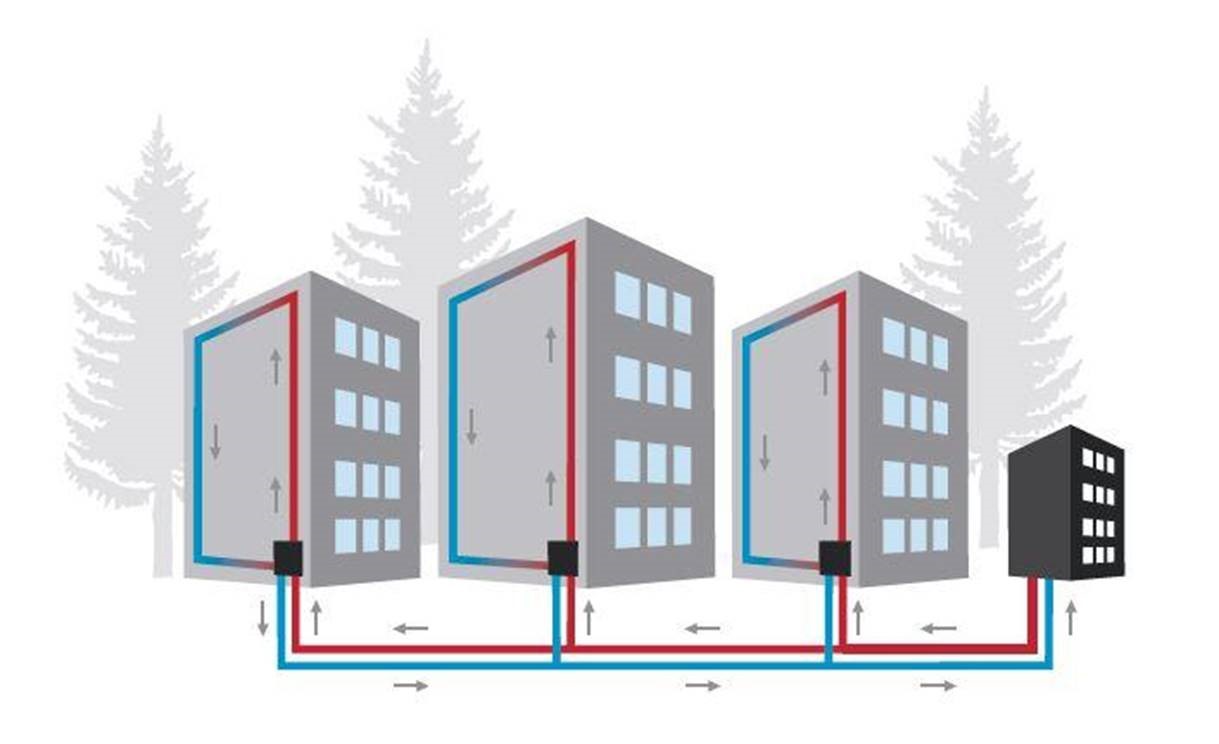Summary
Energy use for heating and cooling is a major contributor to greenhouse gas emissions. As such, it presents a clear opportunity for municipalities to reduce their carbon footprints. New Westminster, B.C., has long recognized that building a district energy system to recover heat from wastewater would be a major step to help them reach their ambitious climate goals. Their newest feasibility study outlines a business case for the Sapperton District Energy System and a plan to make it a reality.
Background
New Westminster is a city of about 70,000 people in British Columbia’s Lower Mainland, along the Fraser River.
In 2011, the city published its Community Energy and Emissions Plan and identified a district energy system as an opportunity that could both help the city decarbonize and provide residents with energy resiliency and affordability. Then, in 2019, city council declared a climate emergency. This declaration included ambitious new greenhouse gas reduction targets of 45 percent by 2030, 65 percent by 2040, and 100 percent by 2050.
Now called the Sapperton District Energy System (SDES), the project would use heat recovered from wastewater from the sewer system to provide heating and cooling and thus reduce demand for natural gas. The system’s primary customers are likely to be:
- The nearby Royal Columbian Hospital, which is currently under expansion
- New mixed use development project Sapperton Green, which will include 4,700 residential units as well as retail, commercial and community space
District energy system moves heat energy from a central facility to nearby buildings via a network of closed-loop pipes.
The challenge
With its new emissions reduction targets in place, New Westminster was ready to make the SDES a reality. While the technical aspects of the project were well understood thanks to previous studies, staff were not yet clear on how to fund and, ultimately, deliver the SDES. The next step was to answer any outstanding questions by completing a new feasibility study and business case. The overall objective was to confirm that this project would work for the city, and to figure out how best to make it happen.
Approach
With approvals in place, New Westminster was able to move forward on its new feasibility study. Study components included:
- A reworked engineering design to ensure plans were up to date
- A project cost estimate
- Engagement with stakeholders to understand and incorporate their needs
- A business case analysis, including potential integration of a private sector partner
- Recommendations for project scope and delivery
- Assessing and optimizing the project’s social, economic and environmental performance
Results
Study authors recommended a phased approach to building the system, beginning with a temporary energy centre at Sapperton Green to be completed in 2023, followed by connection to the hospital in 2025 and then further expansion in 2027 and beyond. They also mentioned that working with partners will be essential to success; this includes:
- Cooperating with Metro Vancouver to secure funding and carbon credit exchange agreements, and to develop the sewer heat resource
- Confirming service agreements with primary customers—Fraser Health Authority and the Sapperton Green developer—in advance of the design phase
Benefits
The new study confirmed that the SDES would have a large impact on New Westminster’s carbon footprint, as well as providing numerous environmental and community benefits. For example:
- It will be placed on a brownfield site, and therefore will be a catalyst to development of this area, including environmental restoration of the Brunette River shoreline.
- It has the potential to improve public space and offer better accessibility and public transportation to the community, such as a Skytrain elevator and crosswalk and a greenway extension.
- It includes several resiliency measures intended to help the community cope better after natural disasters.
- It could provide a savings of up to 120,000 tonnes of carbon dioxide equivalent over 25 years, for a 30 to 40 percent reduction in greenhouse gas emissions.
The Sapperton District Energy Facility will recover heat from sewage and transfer it to connected buildings.
Lessons learned
The feasibility study produced an updated business case that filled in knowledge gaps and was valuable in moving the project forward. By engaging stakeholders throughout the process, the project team also ensured their input was included and got their buy-in on the final report.
Staff also recommend structuring these kinds of projects so that detailed information is available when needed, rather than moving forward with incomplete data. While extended timelines can feel like an unnecessary delay, in cases where there is a good reason for them, they may actually result in a better report and business case.
Next steps
In March 2022, Metro Vancouver and the City of New Westminster announced a partnership to build the SDES, with an investment from Metro Vancouver of up to $18 million. In addition, the following work is in progress:
- Developing agreements with Metro Vancouver for sewage and connection to the sewer trunk
- Developing a service agreement with the Fraser Health Authority
- Discussing grant funding opportunities with provincial and federal entities
- Performing investigations at the newly acquired project site
New Westminster City Council is also working on a new District Energy Bylaw that will move the project into action.
